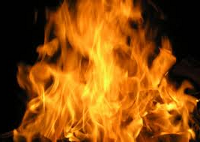Flash Points - Liquids
The flash points for some common liquids and fuels.
The flash point of a chemical substance is the lowest temperature where enough fluid can evaporate to form a combustible concentration of gas.
The flash point is an indication of how easy a chemical may burn. Materials with higher flash points are less flammable or hazardous than chemicals with lower flash points.

Some liquids and their flash points at atmospheric pressure:
See also Autoignition temperature and flash point of different hydrocarbons
| Fuel | Flash Point (oF) |
|---|---|
| Acetaldehyde | -36 |
| Acetone | 0 |
| Acentonitrile | 43 |
| Acrylonitrile | 32 |
| Allyamine | -20 |
| Aniline | 158 |
| Anisole | 126 |
| Benzene | 12 |
| Benzaldehyde | 145 |
| Biodiesel | 266 |
| Butanal | -7.6 |
| n-Butane | -76 |
| 1-Butanol | 99 |
| Carbon Disulfide | -22 |
| Cyclohexanone | 111 |
| Diesel Fuel (1-D) | 100 |
| Diesel Fuel (2-D) | 126 |
| Diesel Fuel (4-D) | 130 |
| Diethanolamine | 342 |
| Diethylene glycol diethyl ether | 180 |
| Diethyl ether | -49 |
| Diisopropyl ether | -18 |
| Dimethyl sulfate | 181 |
| Dimethyl sulfide | -35 |
| Ethyl Alcohol (Ethanol) | 63 |
| Ethylamine | 3.2 |
| Formaldehyde | 185 |
| Fuels Oil No.1 | 100 - 162 |
| Fuels Oil No.2 | 126 - 204 |
| Fuels Oil No.4 | 142 - 240 |
| Fuels Oil No.5 Lite | 156 - 336 |
| Fuels Oil No.5 Heavy | 160 - 250 |
| Fuels Oil No.6 | 150 |
| Furfural | 140 |
| Furfuryl alcohol | 167 |
| Gasoline | -45 |
| Gear oil | 375 - 580 |
| Hexylamine | 84 |
| Iso-Butane | -117 |
| Iso-Pentane | less than -60 |
| Iso-Octane | 10 |
| Isopropylbenzene hydroperoxide | 347 |
| Jet fuel (A/A-1) | 100 - 150 |
| Kerosene (paraffin) | 100 - 162 |
| Methyl Alcohol (Methanol) | 52 |
| Methylamine | 32 |
| Motor oil | 420 - 485 |
| Naphtha | 32 - 86 |
| n-Pentane | less than -40 |
| n-Hexane | -7 |
| n-Heptane | 25 |
| n-Octane | 56 |
| Naphthalene | 174 |
| NeoHexane | -54 |
| Paraldehyde | 97 |
| Peroxyacetic acid | 106 |
| Petroleum ether | < 0 |
| Propanal | -22 |
| Propane | -156 |
| 2-Propanol | 54 |
| Propylamine | -35 |
| Styrene | 90 |
| Tetrohydrofuran | 151 |
| Toluene | 40 |
| Triethanolamine | 354 |
| Triethylamine | 19 |
| o-Xylene | 63 |
| m-Xylene | 81 |
| p-Xylene | 81 |
- T (oC) = 5/9 (T (oF) - 32)
Note! - the Auto-Ignition Temperature is not the same as Flash Point - The Auto-Ignition Temperature indicates the minimum temperature required to ignite a gas or vapor in air without a spark or flame being present . Temperature classification of equipment in hazardous areas are related to surrounding substances auto-ignition temperature.



